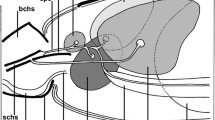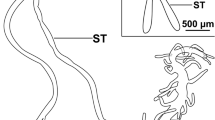Summary
The larval salivary gland secretions ofBombus atratus were studied with cytochemical and cytophysical methods. In the young feeding larvae a proteic filamentous secretion depicting striations perpendicular to the long axis of its fibrillary threads and exhibiting a wellordered macromolecular array was found. It appears not to differ from the silk secretion described for the fully grown larvae of an europeanBombus species. However, in the fully grown larvae ofB. atratus changes which have not yet been reported for other bees occur involving the salivary gland secretion. Two secretion types are then distinguishable. One is composed of carboxylated and sulfated acid glycosaminoglycans and glycoprotein(s) (mucous secretion), and the other has the same composition as that of the filamentous secretion of the young larvae, although differing morphologically and in terms of macromolecular alignment (flocculent secretion). The filamentous secretion is assumed to be involved inB. atratus with the spinning of the “silken partitions” which at a relatively early stage separate the larvae reared within a common cell from one another. The mucous and flocculent secretions will participate in the cocoons which will cover the pupating larvae. The filamentous and flocculent secretions appear to contain an α-helical fibroin, glycoprotein(s) and lipoprotein(s), but not collagen-type proteins.
Similar content being viewed by others
References
Fischer, E. R., Lillie, R. D., 1954: The effect of methylation on basophilia. J. Histochem. Cytochem.2, 81–87.
Flower, N. E., Kenchington, W., 1967: Studies on insect fibrous proteins: the larval silk ofApis, Bombus andVespa. J. roy. micr. Soc.86, 297–310.
Lev, R., Spicer, S. S., 1964: Specific staining of sulphate groups with alcian blue at low pH. J. Histochem. Cytochem.12, 309.
Lillie, R. D., 1958: Acetylation and nitrosation of tissue amines in histochemistry. J. Histochem. Cytochem.6, 352–362.
Lison, L., 1960: Histochimie et Cytochimie Animales. Paris: Gauthier-Villars.
Lucas, F., Rudall, K. M., 1967: Extracellular fibrous proteins: the silks. In: Comprehensive Biochemistry26, 475–558 (M. Florkin andE. H. Stotz, ed.). Amsterdam: Elsevier Publ,
Mello, M. L. S., 1979: A mucous secretion in the Malpighian tubes of a neotropical bumblebee,Bombus atratus Franklin. Protoplasma99, 147–158.
—,Vidal, B. C., 1971: Histochemical and histophysical aspects of silk secretion inMelipona quadrifasciata (Hym., Apoidea). Z. Zeilforsch.118, 555–569.
Penzer, G. R., 1972: 1-anilinonaphthalene-8-sulphonate. The dependence of emission spectra on molecular conformation studied by fluorescence and proton-magnetic resonance. Eur. J. Biochem.25, 218–228.
Rosselet, A., Ruch, F., 1968: Cytofluorometric determination of lysine with dansylchloride. J. Histochem. Cytochem.16, 459–466.
Rudall, K. M., 1962: Silk and other cocoon proteins. In: Comparative Biochemistry4, 397–433. New York-London: Academic Press.
—,Kenchington, W., 1971: Arthropod silks: the problem of fibrous proteins in animal tissues. Ann. Rev. Entom.16, 73–96.
Sakagami, S. F., Akahira, Y., Zucchi, R., 1967: Nest architecture and brood development in a neotropical bumble-bee,Bombus atratus. Insectes sociaux14, 389–414.
Spicer, S. S., Lillie, R. D., 1959: Saponification as a means of selectively reversing the methylation blockage of tissue basophilia. J. Histochem. Cytochem.7, 123–125.
Vidal, B. C., 1970: Dichroism on collagen bundles stained with xylidine ponceau 2 R. Ann. Histochim.15, 289–296.
—, 1978: The use of the fluorescent probe 8-anilinonaphthalene sulfate (ANS) for collagen and elastin histochemistry. J. Histochem. Cytochem.26, 196–201.
- 1979: Feixes de colágeno: detecção e quantificação de ordem macromolecular. I. Dicroísmo com corantes azoicos sulfatados (Orange G, Xylidine Ponceau e Sirius Red). Ciênc. Cult. (in press).
White, A., Handler, P., Smith, E. L., 1964: Principles of Biochemistry. New York: McGraw-Hill, Inc.
Zerlotti, E., Engel, M. B., 1962: The reactivity of proteins of some connective tissues and epithelial structures with 2,4-dinitrofluorobenzene. J. Histochem. Cytochem.10, 537–546.
Author information
Authors and Affiliations
Rights and permissions
About this article
Cite this article
Mello, M.L.S., Vidal, B.C. The salivary gland secretions of a neotropical bumblebee. Protoplasma 100, 251–265 (1979). https://doi.org/10.1007/BF01279315
Received:
Accepted:
Issue Date:
DOI: https://doi.org/10.1007/BF01279315




